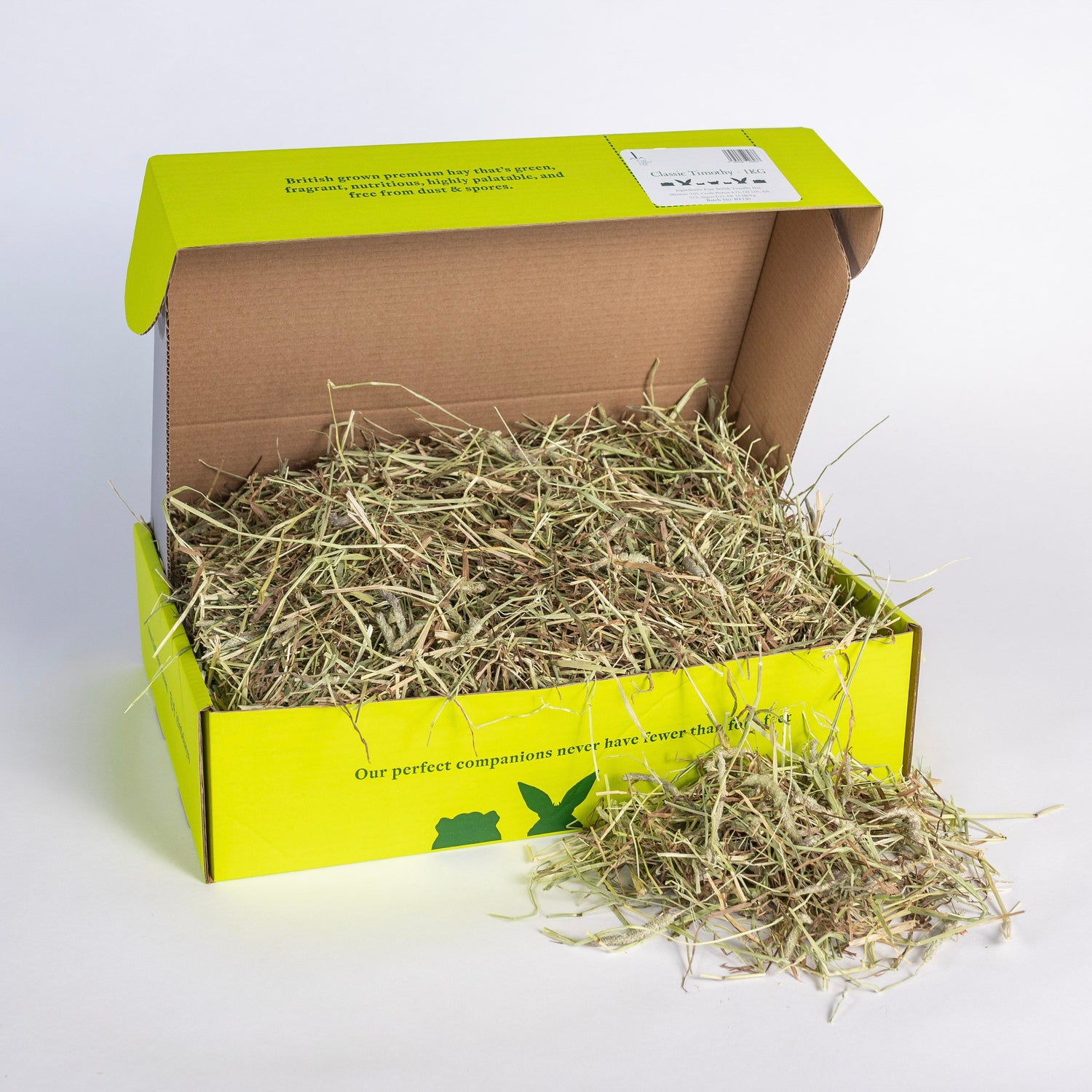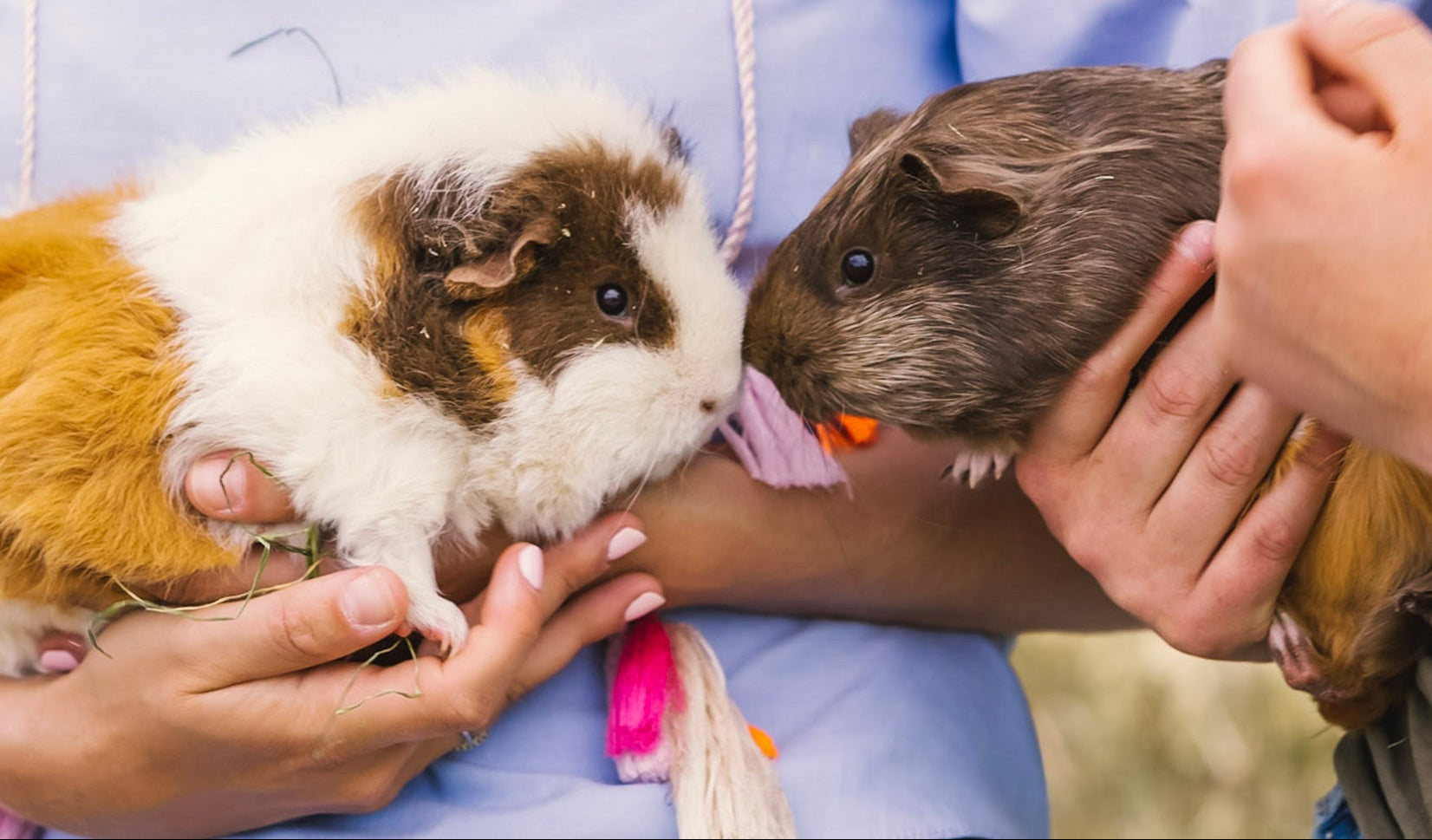Timothy Hay is fibre rich, low in calcium and perfect for small animals.
Timothy Hay may sound like an enchanting character from Peter Rabbit, but it is actually the name of one of the most popular foods to feed rabbits, guinea pigs and other small animals.
What is Timothy Hay?
Timothy Hay is a grass hay. It can grow high, up to around 6 feet tall. There are three varieties you can buy. At the Little Hay Company, we offer a Premium Cut Timothy Hay.
This Premium Cut Timothy Hay has a long strand and has soft flowery heads. Our Premium Cut Timothy Hay is ideal for digestion and teeth health for your small hay eating pets.
The three cuts of Timothy Hay are the first cut, second cut and third cut. The first cut has the highest fibre rating but is lower in nutritional value, it is also the hardest of the cuts. The second cut is more balanced between fibre and protein. The third cut is softer and greener with less fibre but more protein. In the UK, we tend to get one cut of timothy on most farms, this is due to our shorter summers and wetter weather. The Little Hay Co Timothy hay is a coarse cut timothy, high in fibre and green in colour and can be enjoyed by most furry herbivore friends.
You can find Timothy Hay in most supermarkets or pet stores, but you may find yourself asking why is my rabbit ignoring its hay? The difference between a standard off the shelf Timothy Hay and Timothy Hay from The Little Hay Company is that we create dust-free hay using our innovative drying system. This helps reduce any allergies and means your favourite little animal is only getting the very best of the grass hay, not the dust too. Our Timothy Hay is also fragrant, has long stems and soft flower heads for variety. As our Timothy Hay also maintains its green colour, it can be visually more appealing to a fussy animal.
We also stock a Canadian Timothy hay. This hay is a supercharged green colour due to the better weather in the Canada, it is still a coarse cut and can be enjoyed as a treat hay.
Where is Timothy Hay grown?
Timothy Hay can be grown just about anywhere. It is popular in the United States and across Europe. The difference will always be in how it is looked after and treated after it's cut. Timothy Hay grown in the UK is a little harder to find, which is why The Little Hay Co have perfected the process of cutting and drying the hay using innovative indoor facilities. This takes the unpredictable British Weather out of the equation and guarantees we can offer the best premium quality Timothy Hay.
Buying British also helps local businesses and reduces the carbon footprint of shipping hay from foreign countries.
Which cut is best for my rabbit and guinea pig
Timothy Hay comes in three cuts. Our small animal friends can be fussy at times, so you may need to experiment to find out which cut they prefer. You can do this through taster bags or general experimentation. Any cut of Timothy Hay is beneficial for their health but balancing their diet is important too. Timothy Hay helps with their digestion, teeth health and has an excellent balance of nutrition, protein, fibre and calcium. Our Premium Cut Timothy Hay gives your pet a perfectly balanced hay diet that is visually appealing, fragrant with a mix of soft flowery heads and rougher stems.
Timothy Hay vs Timothy Grass
There are a couple of differences between Timothy Hay and Timothy Grass. The first is colour. Timothy Grass is usually greener than Timothy Hay. Secondly, it is slightly higher in protein.
As Timothy Hay is dried, it can lose its colour, but it is still high in fibre and low in protein. Timothy Hay also lasts for years if kept correctly. Grasses do not last very long at all.
The Little Hay Company uses an innovative drying technique for its Timothy Hay which helps it retain much of its green colour. This makes our Hay more visually appealing to small animals and more fragrant too.
Why is it called Timothy Hay
A farmer named Timothy Hanson in the United States introduced Timothy Hay across the country in the early 18th century. His recommendation made the hay a staple diet of cattle in the US and later in the UK. His first name became linked with the type of Hay he originally introduced.
Nutrition Values of Timothy Hay
Nutritional Breakdown of Hay & Grass:*
| Hay Type | Crude Fibre | Crude Protein | Calcium |
| Orchard Grass | 34% | 10% | 0.33% |
| Timothy Hay | 32-34% | 8-11% | 0.4-0.6% |
| Oat | 31% | 10% | 0.4% |
| Dried Grass | 22-28% | 12-14% | 0.55% |
| Meadow | 33% | 7% | 0.6% |
| Alfalfa | 28-34% | 13-19% | 1.2-1.4% |
| Bermudagrass | 29% | 10% | 0.46% |
Other Types of Hay
Timothy Hay is a popular choice for feeding your small hay eating pet. But there are other hay choices available too. So, if your little friend does not take to Timothy Hay, you can try them on Orchard Hay, Oat Hay, Meadow Hay, Rye Grass Hay, Mixed Hay, Herbal Hay, Wheat and Barley Hay and Alfalfa Hay.
It can be confusing to know which hay type to choose. Check out our detailed Which Hay to choose blog, which can help you narrow down the best hay choice for your small animal.
Difference between Meadow Hay and Timothy Hay
Although our Premium Cut Timothy Hay does include some soft leaves, meadow hay will contain more leaf than Timothy Hay. This means Meadow Hay has a softer overall texture than Timothy Hay. Meadow Hay can also includes edible plants like dandelions, thistles and daisies. Some animals prefer a softer texture, but you will lose some of the benefits for their teeth that the slightly rougher Timothy Hay provides.
Is Timothy Hay good for my rabbit?
Timothy Hay is a brilliant food choice for rabbits. It is popular throughout the world. For rabbits, the main reasons for choosing Timothy Hay are:
Fibre
Timothy Hay is high in fibre which is essential to a rabbit’s health. Rabbits need a lot of fibre to function. By providing Timothy Hay, you can help prevent gut problems like gastrointestinal stasis, in essence, keep them from clogging up.
Healthy Teeth
Rabbit teeth grow and grow a lot. Your rabbit’s teeth could grow up to 5 inches in a year if left unchecked. Timothy Hay with its naturally high fibre and texture can help keep your bunny’s teeth from growing too long as the eating wears them down. Additionally, eating rough hay can keep your rabbit from developing sharp points on their teeth which can be painful. Timothy Hay does two jobs to help your rabbit's teeth stay healthy.
Calcium
Rabbits are designed to take in lots of calcium from their food. This can lead to problems if their food source is rich in calcium. Providing Timothy Hay which is naturally low in calcium can help prevent issues such as bladder sludge.
How much hay do rabbits eat
A rabbit will usually eat as much as you give it. We recommend giving your rabbit the same size portion as its body size every day. Check out our rabbit care guide and download and our printable rabbit diet sheet.
Is Timothy Hay good for guinea pigs
Just like rabbits, guinea pigs will get a lot from Timothy Hay. They will take all the vitamins and minerals from the leaves and the rougher stems will help wear down their teeth and keep them healthy too. Timothy Hay is popular for guinea pigs for good reason.
How much hay do guinea pigs eat?
It is quite difficult to tell how much hay guinea pigs eat. You’ll provide the hay, and your furry friend may eat some and then use the rest for bedding and nesting material. If you were to measure though, we suggest a guinea pig will consume the same amount of hay as their body size per day. You cannot give a guinea pig too much hay but be sure to keep an eye on hay levels each day, so they have enough.
Timothy Hay Boxes
Check our high quality, dust free timothy hay boxes delivered to your door. Note that you can also subscribe and get 10% discount.
| Classic Eco Timothy Hay - £5.99 |
| Premium Timothy Hay - £15.49 |
| Big Eco Box Timothy Hay - £15.00 |













